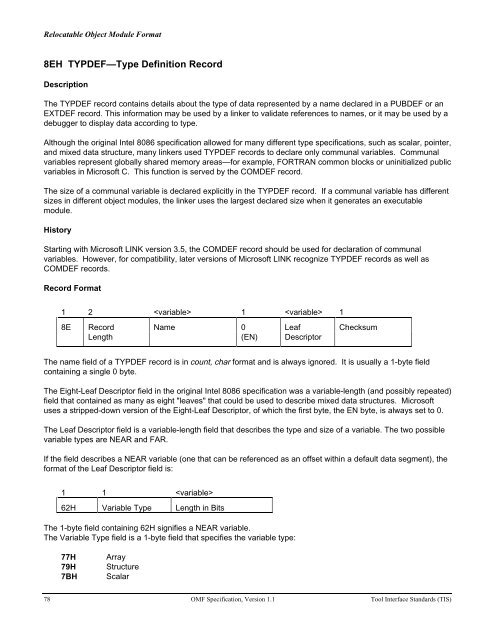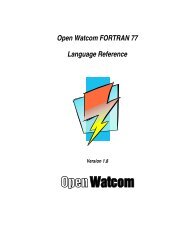Relocatable Object Module Format (OMF) Specification
Relocatable Object Module Format (OMF) Specification
Relocatable Object Module Format (OMF) Specification
You also want an ePaper? Increase the reach of your titles
YUMPU automatically turns print PDFs into web optimized ePapers that Google loves.
<strong>Relocatable</strong> <strong>Object</strong> <strong>Module</strong> <strong>Format</strong><br />
8EH TYPDEF—Type Definition Record<br />
Description<br />
The TYPDEF record contains details about the type of data represented by a name declared in a PUBDEF or an<br />
EXTDEF record. This information may be used by a linker to validate references to names, or it may be used by a<br />
debugger to display data according to type.<br />
Although the original Intel 8086 specification allowed for many different type specifications, such as scalar, pointer,<br />
and mixed data structure, many linkers used TYPDEF records to declare only communal variables. Communal<br />
variables represent globally shared memory areas—for example, FORTRAN common blocks or uninitialized public<br />
variables in Microsoft C. This function is served by the COMDEF record.<br />
The size of a communal variable is declared explicitly in the TYPDEF record. If a communal variable has different<br />
sizes in different object modules, the linker uses the largest declared size when it generates an executable<br />
module.<br />
History<br />
Starting with Microsoft LINK version 3.5, the COMDEF record should be used for declaration of communal<br />
variables. However, for compatibility, later versions of Microsoft LINK recognize TYPDEF records as well as<br />
COMDEF records.<br />
Record <strong>Format</strong><br />
1 2 1 1<br />
8E Record Name 0 Leaf Checksum<br />
Length (EN) Descriptor<br />
The name field of a TYPDEF record is in count, char format and is always ignored. It is usually a 1-byte field<br />
containing a single 0 byte.<br />
The Eight-Leaf Descriptor field in the original Intel 8086 specification was a variable-length (and possibly repeated)<br />
field that contained as many as eight "leaves" that could be used to describe mixed data structures. Microsoft<br />
uses a stripped-down version of the Eight-Leaf Descriptor, of which the first byte, the EN byte, is always set to 0.<br />
The Leaf Descriptor field is a variable-length field that describes the type and size of a variable. The two possible<br />
variable types are NEAR and FAR.<br />
If the field describes a NEAR variable (one that can be referenced as an offset within a default data segment), the<br />
format of the Leaf Descriptor field is:<br />
1 1 <br />
62H Variable Type Length in Bits<br />
The 1-byte field containing 62H signifies a NEAR variable.<br />
The Variable Type field is a 1-byte field that specifies the variable type:<br />
77H<br />
79H<br />
7BH<br />
Array<br />
Structure<br />
Scalar<br />
78 <strong>OMF</strong> <strong>Specification</strong>, Version 1.1 Tool Interface Standards (TIS)
















